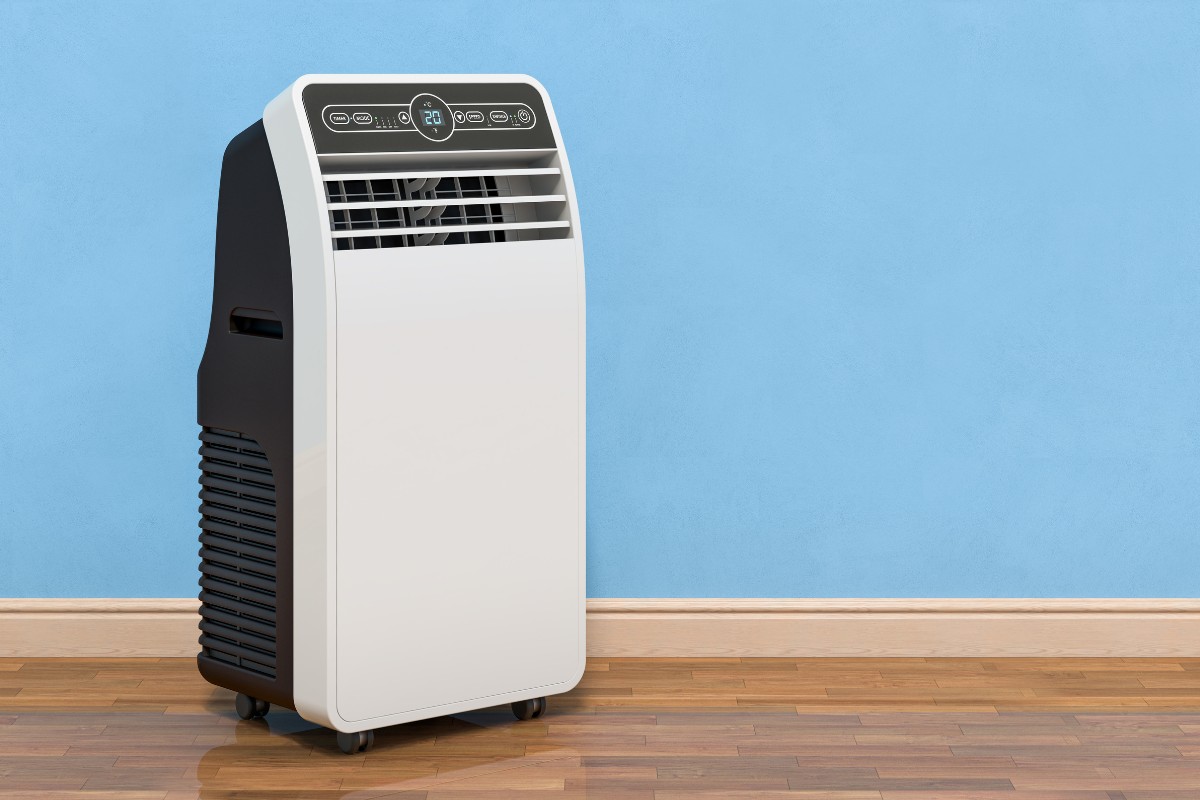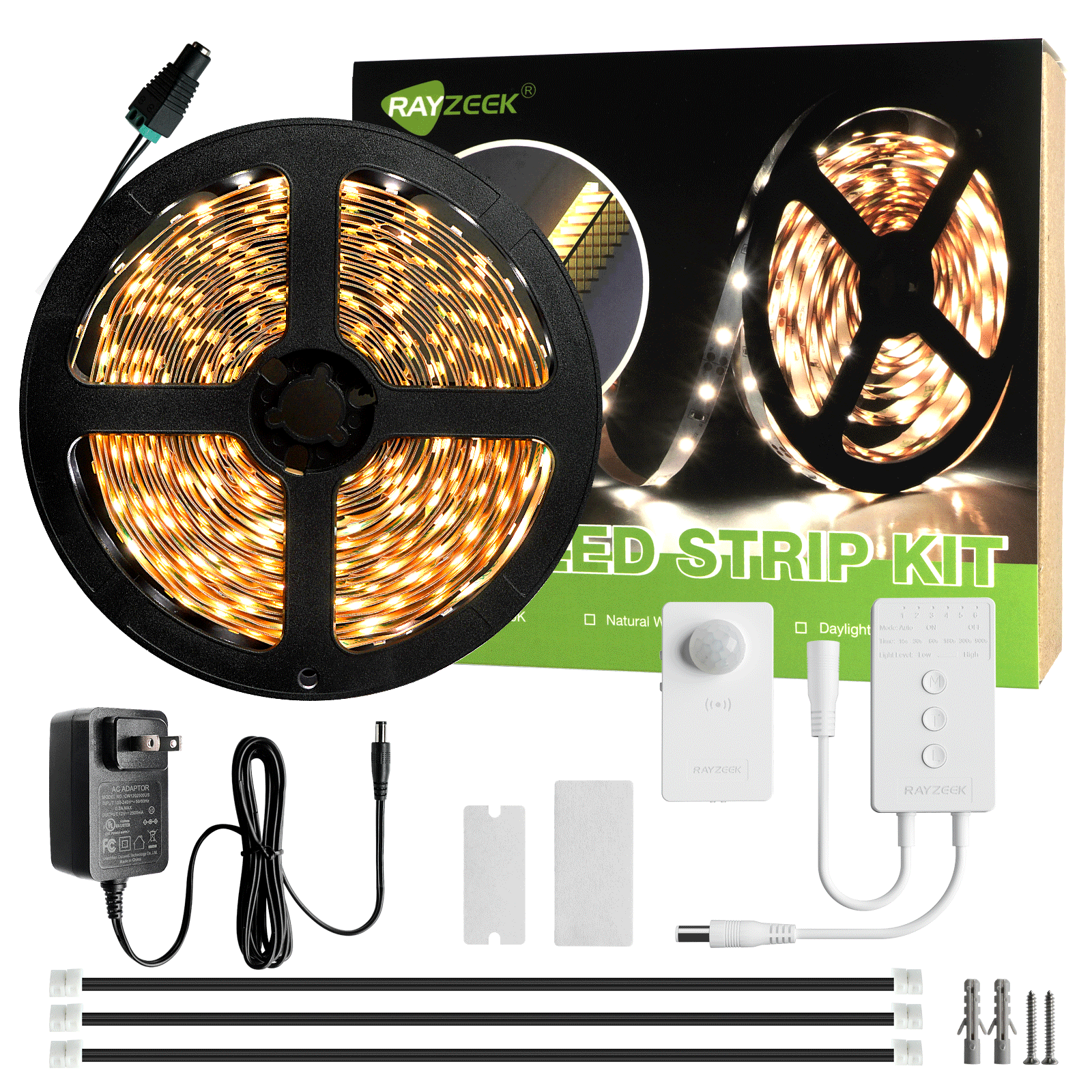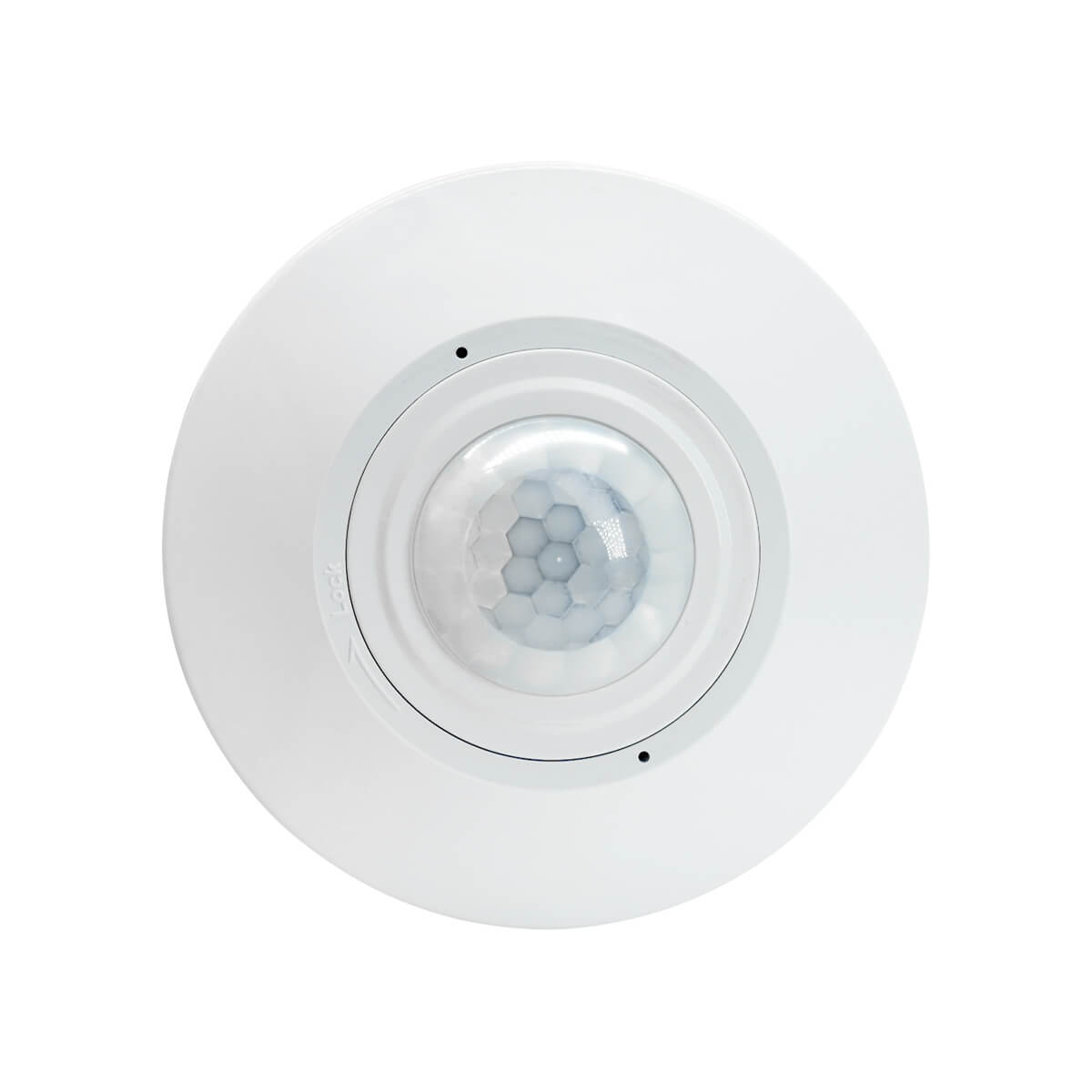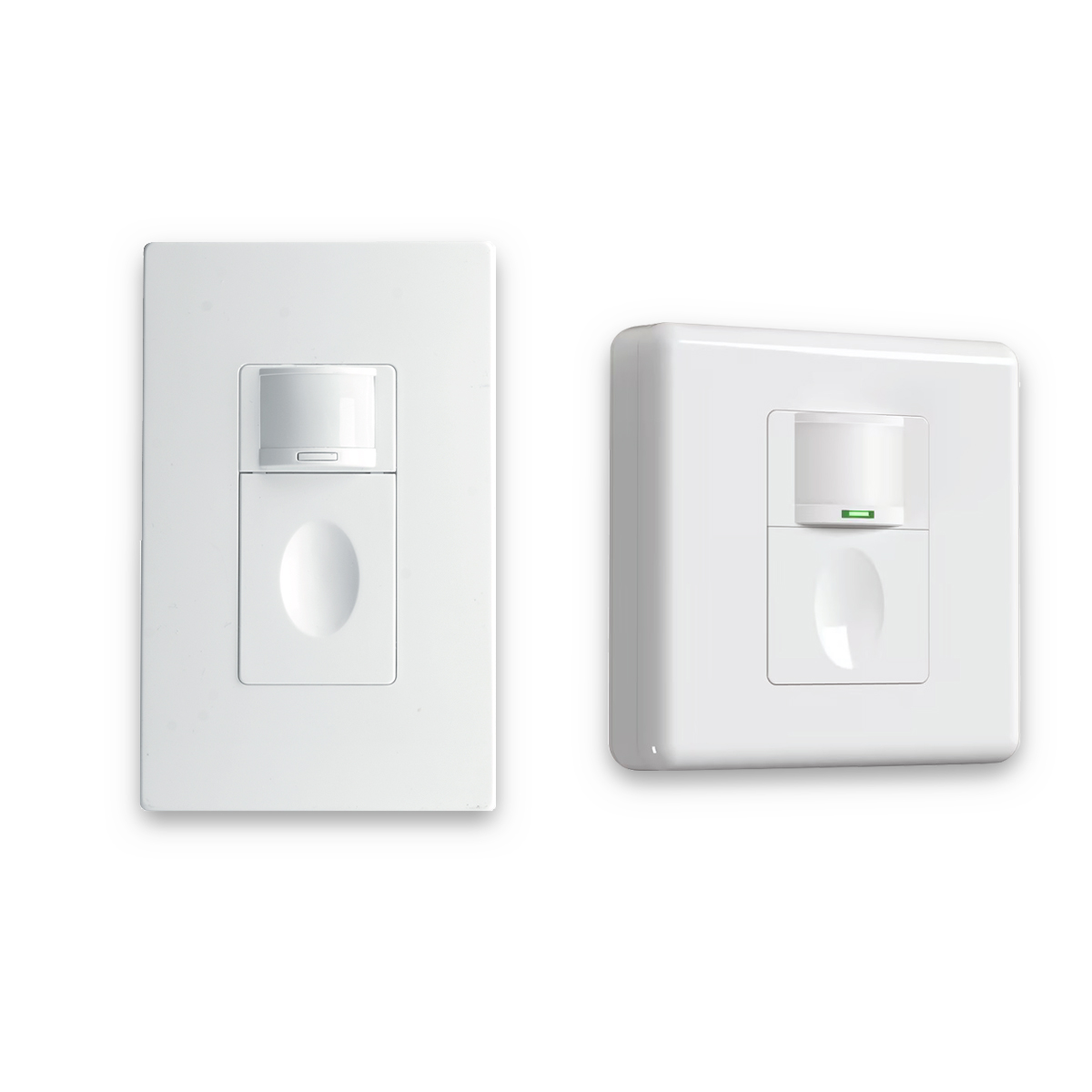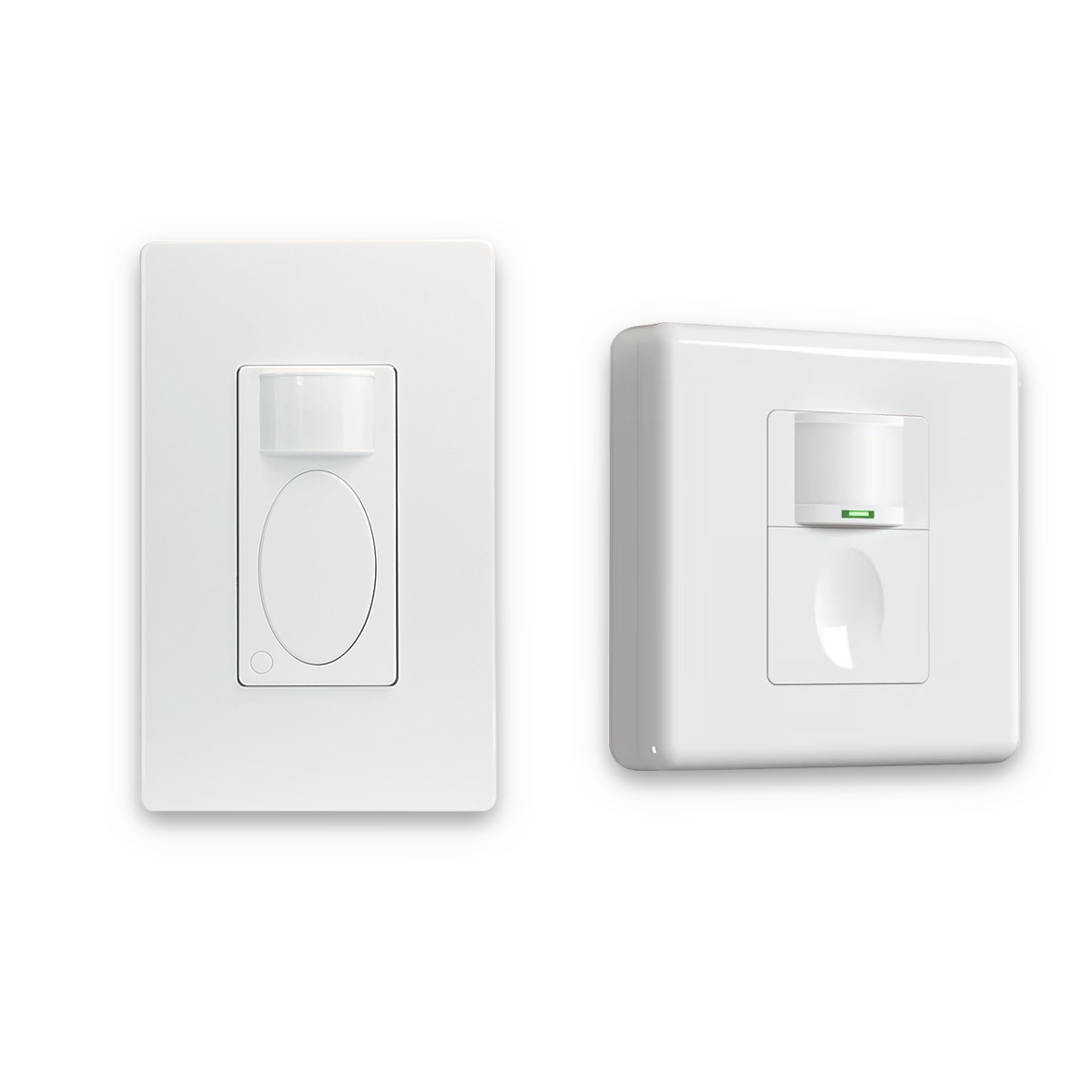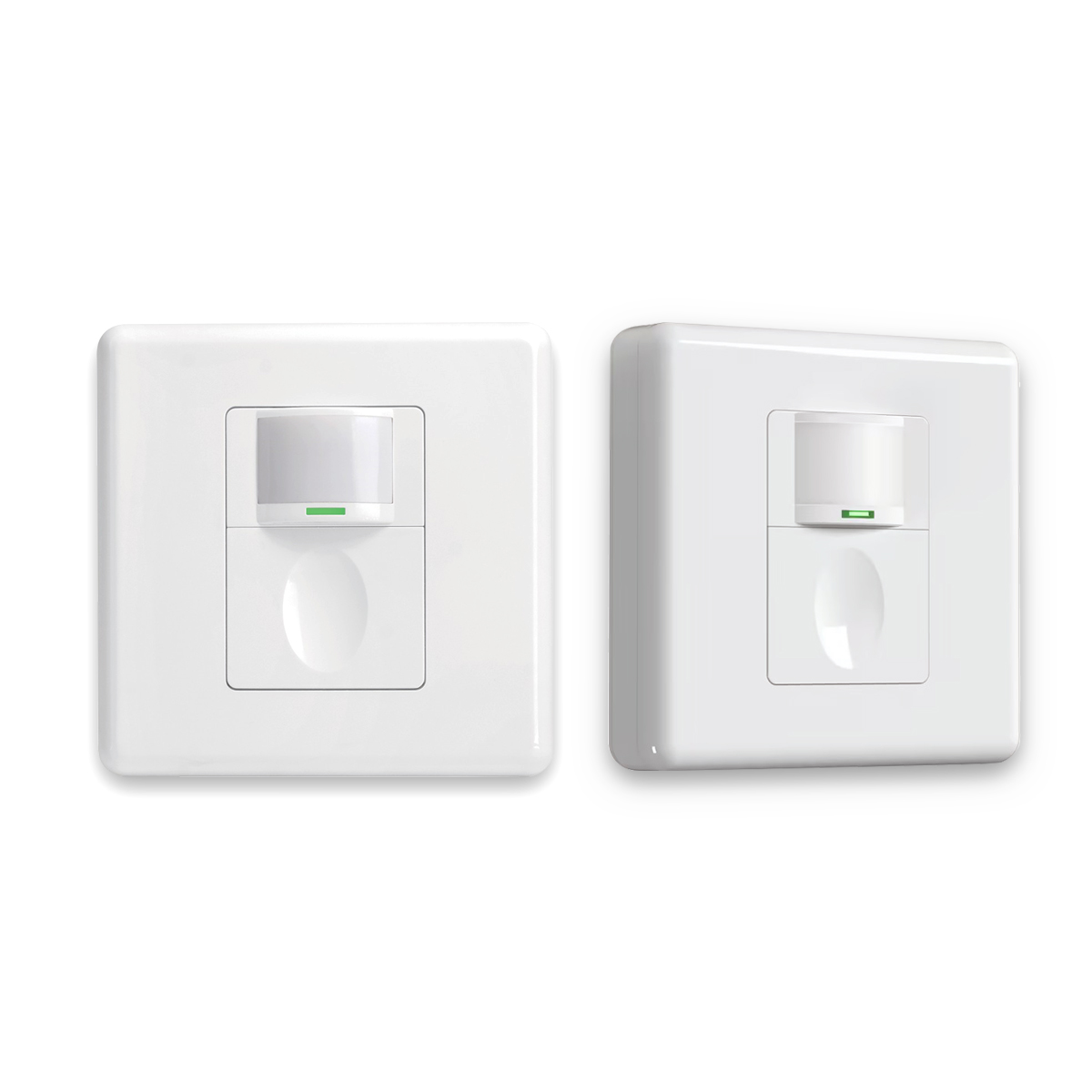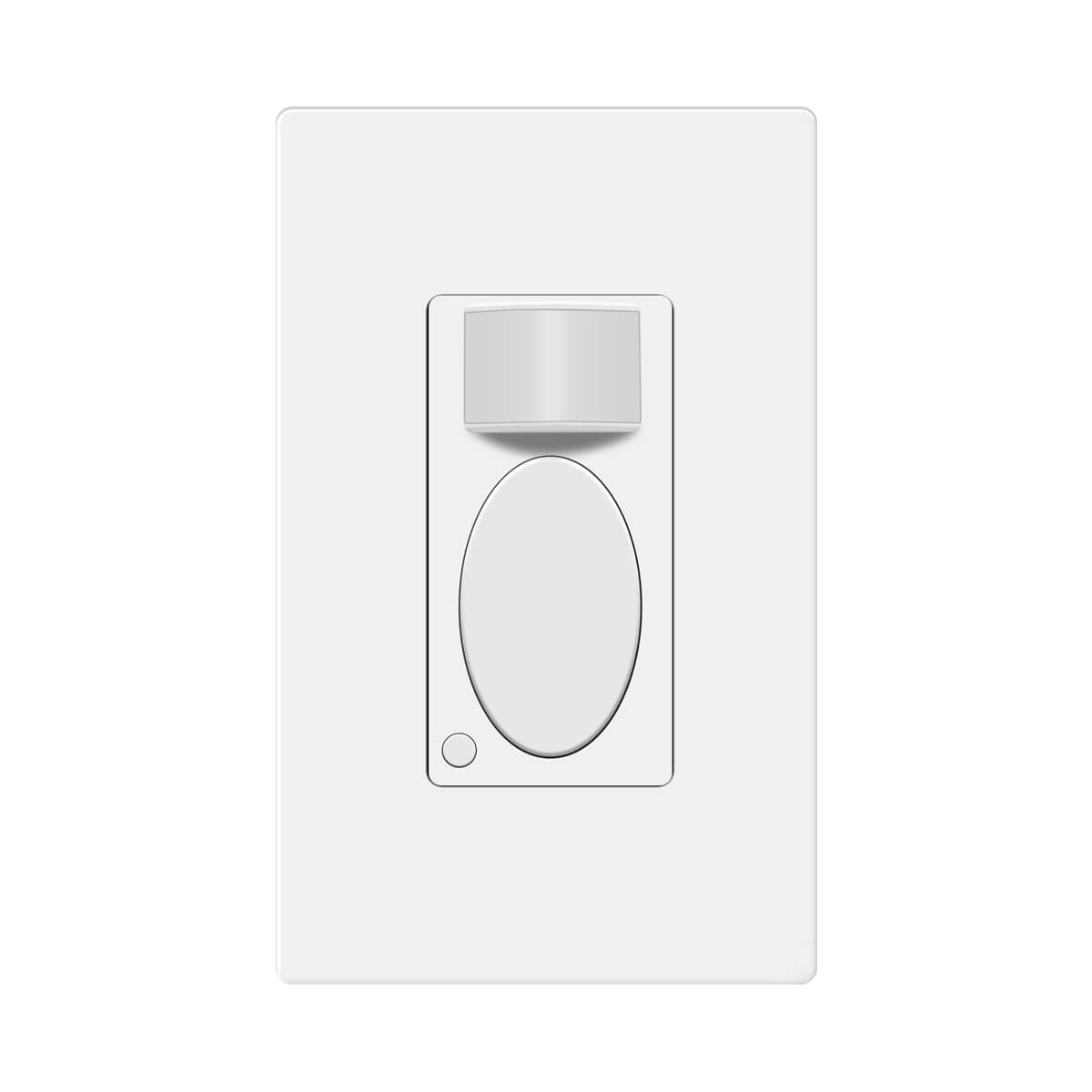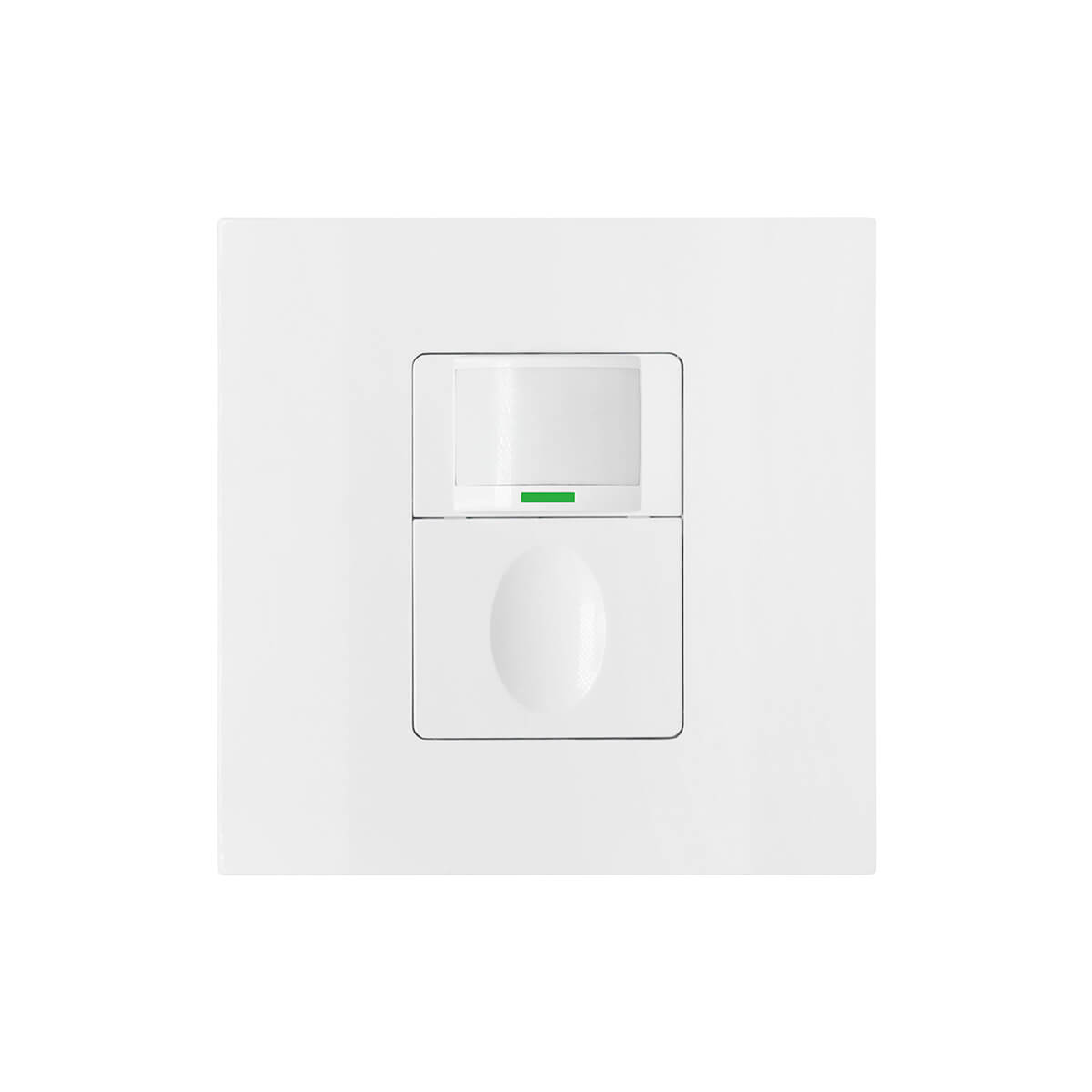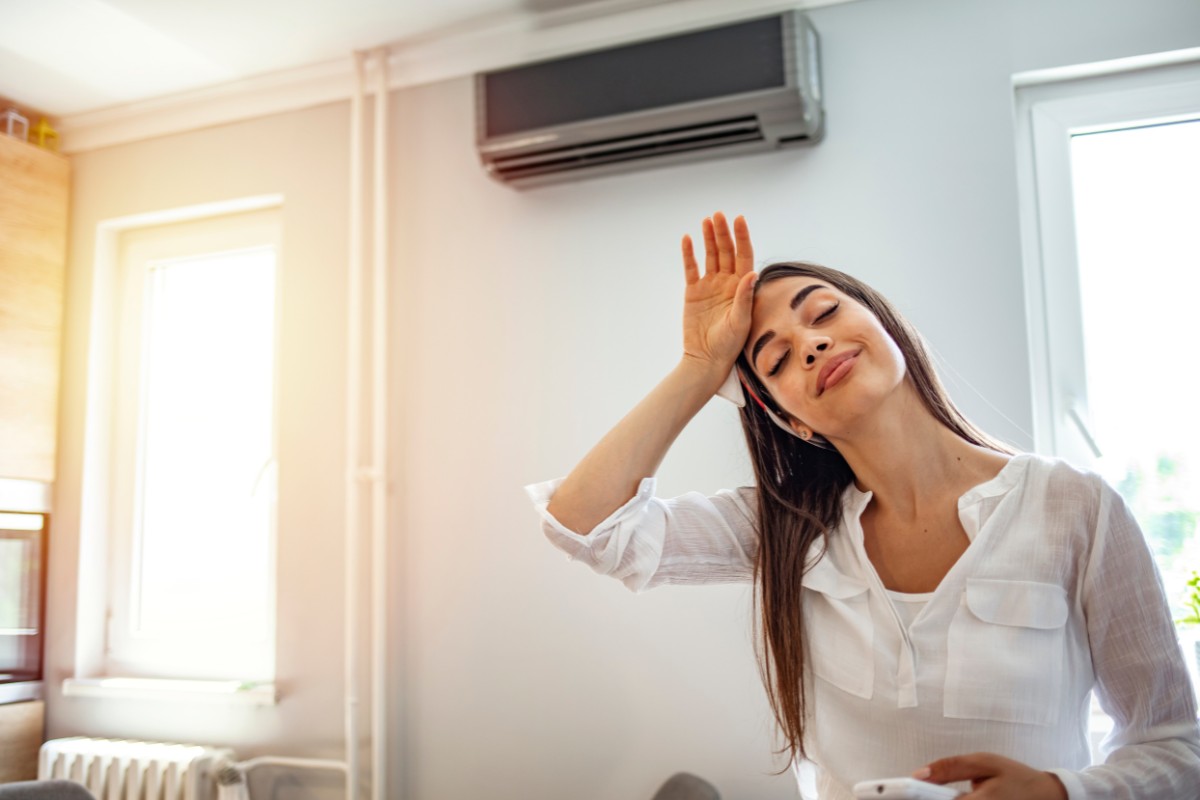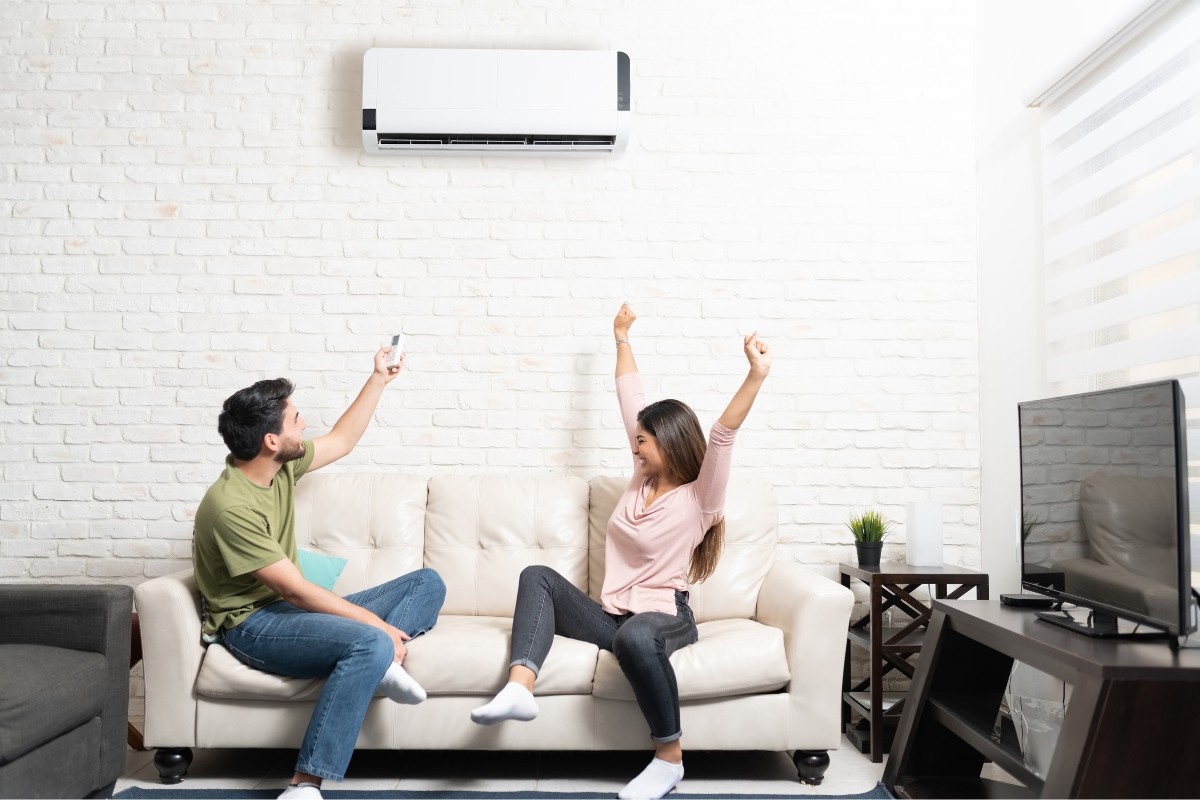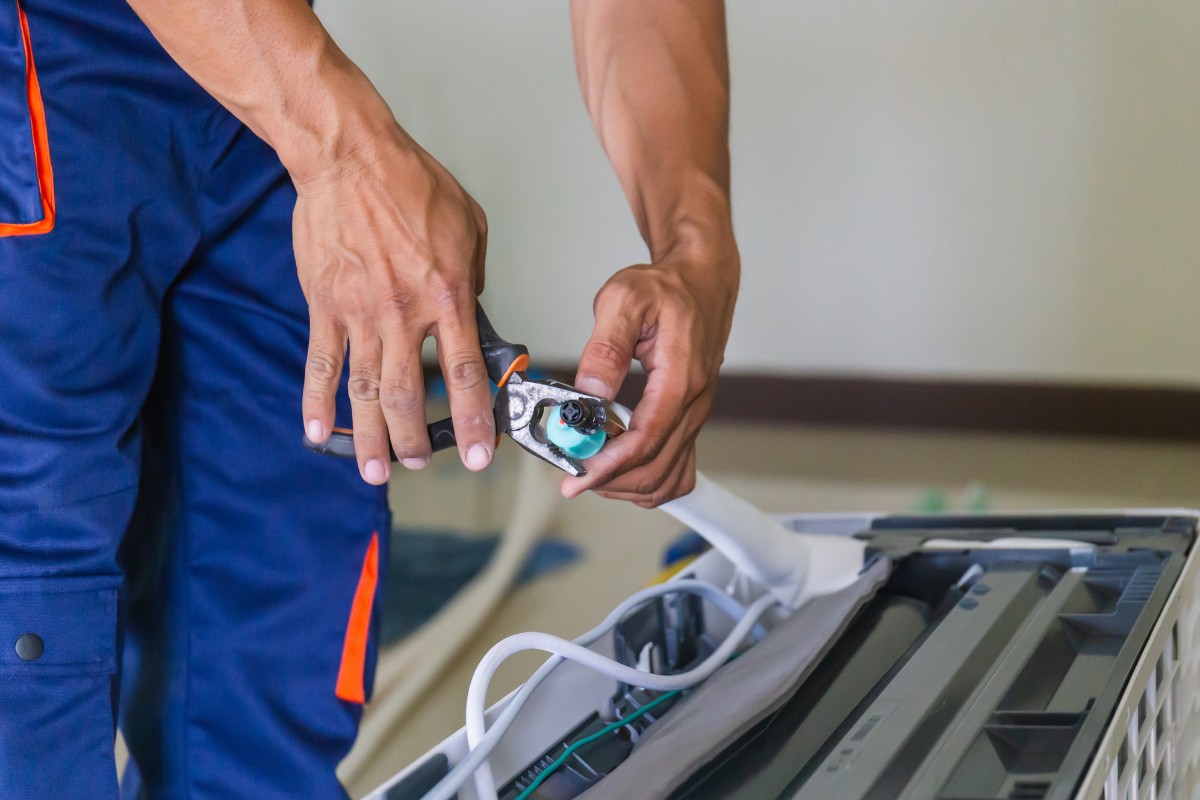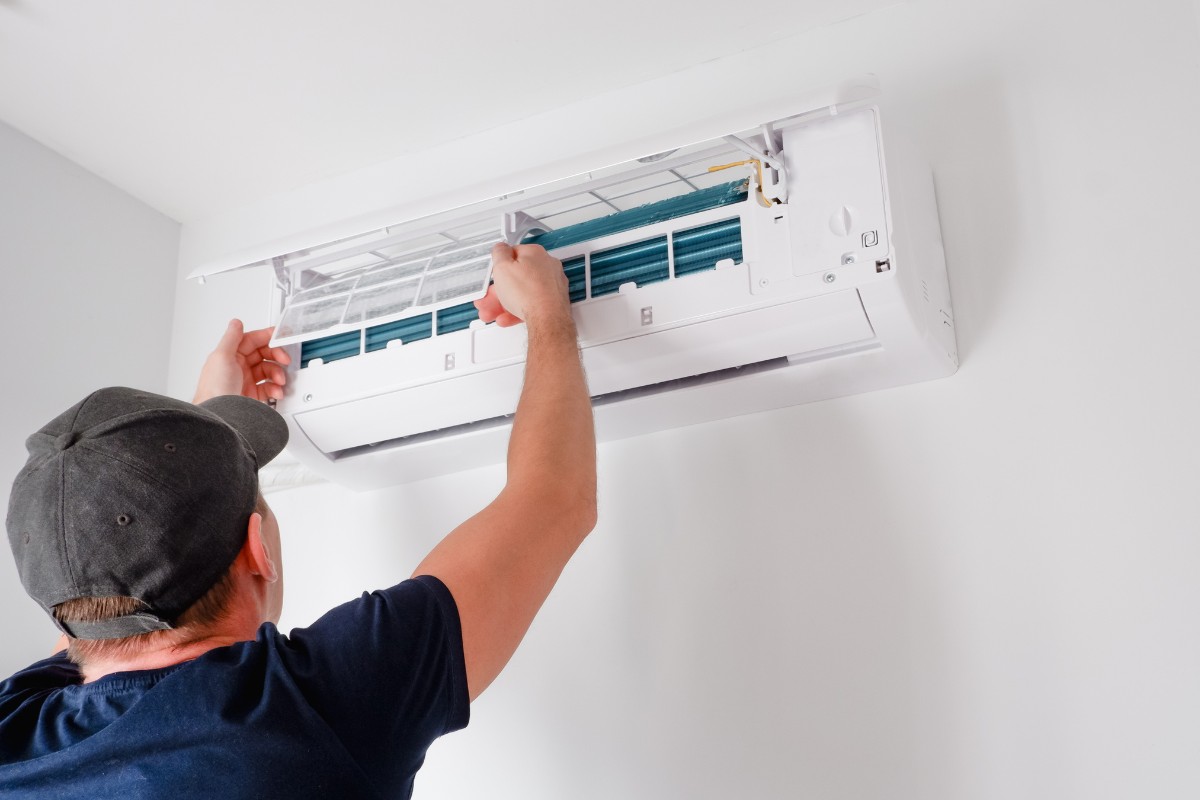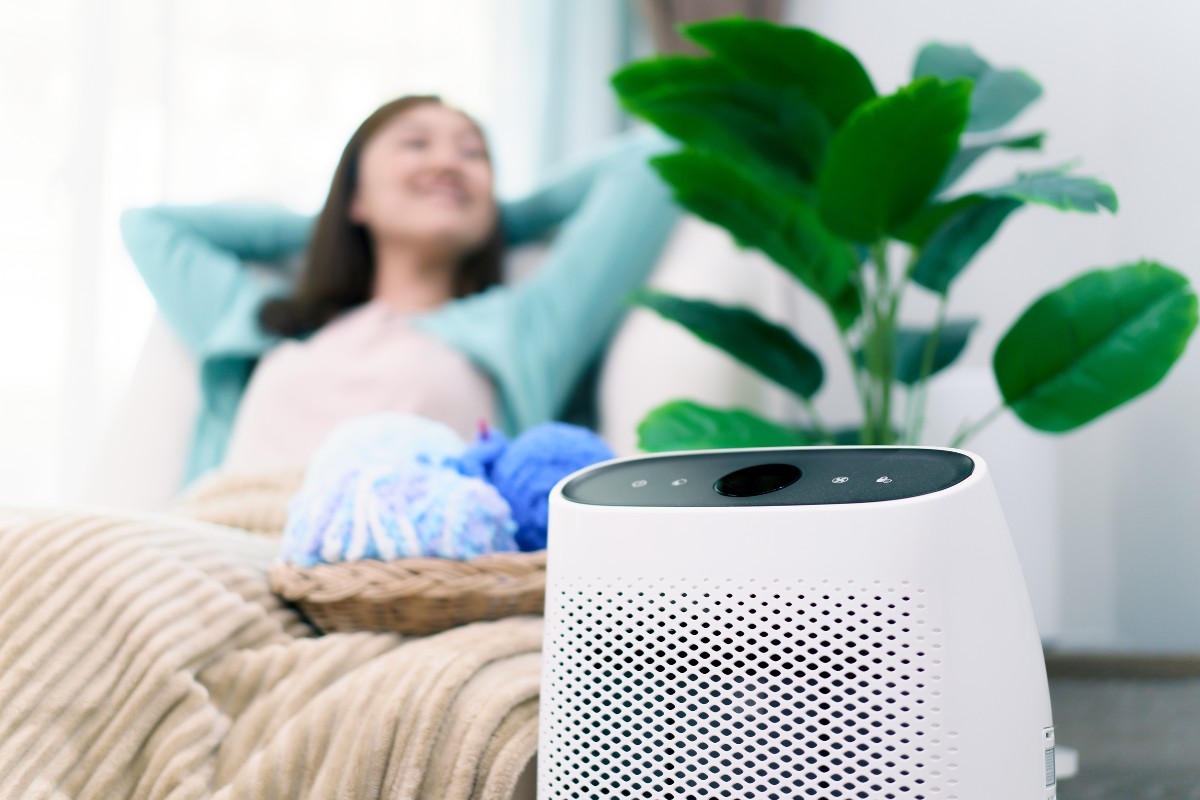Вы когда-нибудь сталкивались с тем, что в комнате, куда не дотягивается центральный кондиционер, знобит? А может быть, вы арендуете квартиру и ищете решение для охлаждения, не требующее постоянных перепланировок? В этом случае на помощь приходят портативные кондиционеры. Переносной кондиционер - это автономный, передвижной охлаждающий блок, предназначенный для локального охлаждения определенной зоны или комнаты. В отличие от оконных или центральных систем кондиционирования, они легко перемещаются и не требуют постоянной установки. Это делает их популярным выбором для домовладельцев, арендаторов, жителей небольших квартир или общежитий, а также для тех, кто нуждается во временном охлаждении.
По сути, портативный кондиционер - это компактное устройство, предназначенное для охлаждения одной комнаты или зоны, предлагающее гибкую альтернативу оконным блокам или центральному кондиционированию. Эти устройства отличаются своей мобильностью: обычно они оснащены колесиками для легкой транспортировки, вытяжным шлангом для отвода горячего воздуха и внутренней системой охлаждения воздуха. В отличие от оконных блоков, которые крепятся на месте, переносные кондиционеры устанавливаются на полу и могут перемещаться из комнаты в комнату по мере необходимости. Важно отметить, что они обычно используются для охлаждения одной комнаты, а не всего дома.
Типы портативных кондиционеров
Когда речь заходит о портативных кондиционерах, обычно встречаются два основных типа: одношланговые и двухшланговые модели. Каждая из них имеет свой набор преимуществ и недостатков, особенно в плане эффективности и холодопроизводительности.
Портативные кондиционеры с одним шлангом
Устройства с одним шлангом - наиболее распространенный и доступный тип, который вы можете найти на рынке. Они используют один шланг для вывода горячего воздуха наружу. Устройство забирает воздух из помещения, охлаждает его, а затем выводит часть воздуха из помещения вместе с горячим воздухом через шланг. При этом в помещении создается небольшое отрицательное давление воздуха. Что это значит? Это означает, что теплый, некондиционированный воздух из других помещений может быть втянут внутрь, что потенциально снижает общую эффективность работы устройства. Этот эффект сильнее проявляется в очень жарком или влажном климате. Несмотря на это, модели с одним шлангом обычно подходят для небольших помещений или зон с умеренными потребностями в охлаждении и отличаются более простым процессом установки по сравнению со своими двухшланговыми аналогами.
Портативные кондиционеры с двумя шлангами
Если вам нужна повышенная эффективность, вам подойдут портативные кондиционеры с двумя шлангами. Как следует из названия, в этих устройствах используются два шланга. Один шланг втягивает свежий воздух извне для охлаждения конденсатора, а другой отводит горячий воздух, образующийся в процессе работы. Такая конструкция предотвращает создание отрицательного давления воздуха в помещении, как это происходит в моделях с одним шлангом. В результате двухшланговые агрегаты могут охлаждать помещение быстрее и эффективнее. Они особенно хорошо подходят для больших помещений или зон с высокой тепловой нагрузкой. Хотя они, как правило, дороже и имеют несколько более сложную установку из-за второго шланга, улучшенная производительность часто оправдывает вложения.
Как работают портативные кондиционеры
Цикл охлаждения
В основе каждого портативного кондиционера лежит холодильный цикл - увлекательный процесс, основанный на парокомпрессионном холодильном цикле. В этом цикле участвует хладагент - специальная жидкость, которая циркулирует по замкнутому контуру, постоянно меняя свое состояние между жидкостью и газом. Давайте разберем основные этапы:
- Испарение: Процесс начинается с того, что жидкий хладагент протекает через змеевик испарителя. Когда теплый воздух в помещении обдувает этот змеевик, хладагент поглощает тепло, в результате чего он испаряется и превращается в газ. Именно здесь и происходит волшебство охлаждения!
- Сжатие: Затем хладагент, который теперь представляет собой газ низкого давления, поступает в компрессор. Этот важнейший компонент сжимает газ, значительно повышая его давление и температуру. Считайте его сердцем системы, перекачивающим хладагент в течение всего цикла.
- Конденсат: Горячий хладагент под высоким давлением поступает в змеевик конденсатора. Здесь тепло, поглощенное из помещения, вместе с теплом, вырабатываемым компрессором, передается наружному воздуху. По мере того как хладагент теряет тепло, он снова конденсируется в жидкость.
- Расширение: Наконец, жидкий хладагент под высоким давлением проходит через расширительный клапан. Этот клапан снижает давление и температуру хладагента, подготавливая его к тому, чтобы начать цикл заново в испарителе.
Вытяжка горячего воздуха
Важнейшим аспектом процесса охлаждения является отвод тепла. Тепло, поглощенное из воздуха в помещении, вместе с теплом, выделяемым компрессором, должно быть выведено наружу. Для этого используется вытяжной шланг. Подключенный к окну или форточке, шланг отводит горячий воздух из помещения. Модели с одним шлангом, как уже говорилось, выводят часть охлажденного воздуха из помещения вместе с горячим воздухом, в то время как модели с двумя шлангами используют наружный воздух для охлаждения конденсатора, что приводит к большей эффективности.
Управление конденсацией
Когда кондиционер охлаждает помещение, влага из воздуха конденсируется на змеевике испарителя. Этот конденсат необходимо удалять, и большинство портативных кондиционеров оснащены системами для его удаления.
Возможно, вы заинтересованы в
- Технология самоиспарения: Многие современные модели оснащены технологией самоиспарения. Эта умная система испаряет собранный конденсат и выводит его через выпускной шланг, избавляя от необходимости ручного опорожнения в большинстве условий.
- Гравитационный слив: Некоторые модели оснащены дренажным шлангом, обеспечивающим непрерывный слив. Это особенно полезно в условиях повышенной влажности, где может скапливаться конденсат.
- Внутренний ковш: Некоторые модели собирают конденсат во внутреннее ведро, которое необходимо периодически опорожнять. Хотя этот способ менее удобен, он все же является приемлемым вариантом для удаления конденсата.
Термодинамические принципы работы
Работа портативного кондиционера регулируется фундаментальными термодинамическими принципами:
- Первый закон термодинамики: Этот закон гласит, что энергия сохраняется. В контексте кондиционера это означает, что тепло, удаленное из помещения, плюс работа, проделанная компрессором, равны теплу, отведенному наружу.
- Второй закон термодинамики: Согласно этому закону, тепло естественным образом перетекает от более горячего тела к более холодному. Холодильный цикл, однако, использует работу (от компрессора) для перемещения тепла против этого естественного потока, перенося его из более холодной комнаты в более теплую внешнюю среду.
- Диаграмма давление-энтальпия: Эта диаграмма - ценный инструмент для визуализации изменений состояния хладагента на протяжении всего цикла. Ключевыми моментами на диаграмме являются изоэнтропийное расширение (дросселирование), изобарный теплообмен (испарение и конденсация) и изоэнтропийное сжатие.
- Коэффициент полезного действия (COP): Эта метрика представляет собой отношение мощности охлаждения к потребляемой электроэнергии. Более высокий COP указывает на большую эффективность, то есть устройство может обеспечить большее охлаждение при данном количестве потребляемой энергии.
Подробный анализ холодильного цикла
Давайте углубимся в тонкости каждой стадии холодильного цикла:
- Испаритель: Жидкий хладагент под низким давлением и низкой температурой поступает в змеевик испарителя. Теплый комнатный воздух обдувает змеевик, заставляя хладагент кипеть и испаряться. Этот процесс поглощает значительное количество тепла, известного как скрытая теплота парообразования. Охлажденный воздух затем циркулирует обратно в помещение, обеспечивая необходимый эффект охлаждения.
- Компрессор: Хладагент, который теперь представляет собой газ низкого давления, поступает в компрессор. Основная функция компрессора - повышение давления и температуры газа-хладагента. Именно здесь расходуется большая часть электроэнергии, поскольку компрессор выполняет "работу" по перемещению тепла против его естественного потока.
- Конденсатор: Затем газ-хладагент под высоким давлением и высокой температурой поступает в змеевик конденсатора. Здесь над змеевиком продувается либо наружный воздух (в моделях с двумя шлангами), либо комнатный воздух (в моделях с одним шлангом). В результате хладагент конденсируется в жидкость, отдавая поглощенное тепло (скрытую теплоту конденсации) во внешнюю среду.
- Расширительный клапан: Наконец, жидкий хладагент под высоким давлением проходит через расширительный клапан, также известный как дроссельный клапан. Этот процесс снижает давление и температуру хладагента, подготавливая его к повторному поступлению в испаритель и началу цикла заново. Процесс расширения является изоэнтропийным, то есть происходит при постоянной энтальпии.
Факторы, влияющие на эффективность охлаждения
На эффективность охлаждения портативного кондиционера могут влиять несколько факторов:
- Температура окружающей среды: Повышенная температура наружного воздуха снижает эффективность конденсатора, заставляя его работать интенсивнее для отвода тепла.
- Влажность: Высокая влажность увеличивает скрытую тепловую нагрузку, требуя от устройства удаления большего количества влаги из воздуха. Это может снизить его чувствительную холодопроизводительность, то есть способность понижать температуру воздуха.
- Скорость воздушного потока (CFM): Более высокая скорость воздушного потока обычно приводит к улучшению теплообмена, позволяя прибору быстрее охлаждать помещение. Однако повышенный воздушный поток может также увеличивать уровень шума.
- Зарядка хладагента: Неправильная заправка хладагентом, слишком высокая или слишком низкая, может существенно повлиять на производительность и эффективность.
- Эффективность компрессора: Эффективность компрессора является основным фактором, определяющим общую эффективность системы. Более эффективный компрессор потребляет меньше энергии при том же объеме охлаждения.
- Проектирование теплообменников: Площадь поверхности, плотность оребрения и материал змеевиков испарителя и конденсатора влияют на скорость теплопередачи. Большая площадь поверхности и более плотные ребра обычно улучшают теплопередачу.
- Изоляция: Правильная изоляция самого устройства и охлаждаемого помещения минимизирует поступление тепла из окружающей среды, повышая эффективность.
- Утечка воздуха: В одношланговых агрегатах инфильтрация воздуха извне из-за отрицательного давления может снизить эффективность.
- Динамика воздушного потока: Конструкция воздухозаборника и вытяжки, включая использование диффузоров и расположение вентиляционных отверстий, может существенно повлиять на характер воздушных потоков в помещении. Это, в свою очередь, влияет на способность устройства эффективно охлаждать помещение. Интересно, что эффект Коандэ, когда струя жидкости стремится удержаться на выпуклой поверхности, может быть использован при разработке более эффективных систем распределения воздуха в портативных кондиционерах.
Основные компоненты портативного кондиционера
Давайте подробнее рассмотрим основные компоненты, из которых состоит портативный кондиционер:
Компрессор
Компрессор часто считают сердцем холодильной системы. Его основная задача - сжимать газообразный хладагент, повышая его давление и температуру. Существует несколько типов компрессоров, включая ротационные, поршневые и спиральные. Однако ротационные компрессоры обычно используются в портативных устройствах благодаря своим компактным размерам и относительно тихой работе.
Конденсатор
Конденсатор - это теплообменник, в котором горячий газ-хладагент под высоким давлением отдает тепло наружному воздуху. Обычно он состоит из медных трубок с алюминиевыми ребрами, чтобы увеличить площадь поверхности для эффективной передачи тепла. Портативные кондиционеры имеют воздушное охлаждение, то есть вентилятор нагнетает воздух над змеевиками конденсатора, чтобы рассеять тепло.
Испаритель
Аналогичный по конструкции конденсатору, испаритель представляет собой еще один теплообменник. Здесь жидкий хладагент поглощает тепло из воздуха в помещении, заставляя его испаряться. Испаритель также состоит из медных трубок с алюминиевыми ребрами, а вентилятор нагнетает воздух над змеевиком, чтобы охладить помещение.
Хладагент
Хладагент - это жизненная сила системы, жидкость, которая поглощает и отдает тепло во время холодильного цикла. В современных портативных кондиционерах обычно используются такие хладагенты, как R-410A (смесь) или R-32 (становится все более популярным из-за его низкого потенциала глобального потепления). В более старых устройствах может использоваться R-22, но этот хладагент постепенно выводится из употребления из-за его потенциала разрушения озонового слоя.
Вентилятор
Вентилятор играет важнейшую роль в циркуляции воздуха над змеевиками испарителя и конденсатора. Обычно это центробежный вентилятор или воздуходувка. Вентиляторы с переменной скоростью вращения становятся все более распространенными, поскольку они могут повысить эффективность и снизить уровень шума, регулируя воздушный поток в зависимости от потребностей в охлаждении.
Выхлопной шланг
Вытяжной шланг - это важный компонент, который выводит горячий воздух из конденсатора наружу. Длина и диаметр шланга, обычно изготовленного из гибкого пластика, могут влиять на поток воздуха и эффективность работы. Обычно рекомендуется держать шланг как можно короче и прямее, чтобы свести к минимуму сопротивление воздушному потоку.
Резервуар для воды или дренажная система
Этот компонент отвечает за сбор или управление конденсатом, удаляемым из воздуха в процессе охлаждения. Самоиспаряющиеся системы, как уже говорилось, в большинстве случаев устраняют необходимость в ручном опорожнении, поскольку испаряют конденсат и выводят его через выхлопной шланг. Гравитационные системы требуют подключения к дренажу, а внутренние ведра необходимо периодически опорожнять. Некоторые передовые системы могут даже использовать собранный конденсат для предварительного охлаждения змеевика конденсатора, что еще больше повышает эффективность. Также ведутся исследования по интеграции управления конденсатом в системы замкнутого цикла для минимизации потерь воды.
Преимущества портативных кондиционеров
Портативные кондиционеры обладают рядом преимуществ, которые делают их привлекательным вариантом охлаждения в различных ситуациях. Их портативность Это особенность, поскольку их можно легко перемещать из одной комнаты в другую с помощью встроенных роликов. Такая гибкость особенно полезна, если вам нужно охлаждать только определенные зоны в разное время. Простая установка еще одно существенное преимущество. В отличие от оконных или центральных систем кондиционирования, портативные устройства, как правило, не требуют постоянной установки. Вы просто подсоединяете вытяжной шланг к окну с помощью прилагаемого комплекта. Это делает их идеальными для дополнительное охлаждениеОбеспечивают дополнительное охлаждение помещений, которые не обслуживаются центральной системой кондиционирования.
Кроме того, портативные кондиционеры позволяют зональное охлаждениеЭто означает, что вы можете охлаждать только ту комнату, которую используете в данный момент. Это может привести к значительной экономии энергии по сравнению с охлаждением всего дома с помощью центральной системы. Они также являются отличным выбором для арендаторов, которые не могут вносить постоянные изменения в свою жилплощадь, так как они требуют никаких постоянных изменений. Наконец, портативные кондиционеры могут быть экономически эффективный вариант для небольших квартир или домов, особенно по сравнению с затратами на установку центрального кондиционера.
Недостатки портативных кондиционеров
Хотя портативные кондиционеры обладают многочисленными преимуществами, у них есть и определенные недостатки, которые следует учитывать. Одним из заметных недостатков является их низкая эффективность по сравнению с оконными блоками или центральными кондиционерами, особенно в случае однорукавных моделей. Это означает, что они могут потреблять больше энергии для достижения того же уровня охлаждения. Кроме того, их ограниченная мощность охлаждения что делает их подходящими для охлаждения отдельных помещений, но не идеальными для больших пространств или нескольких комнат. Шум Также может вызывать беспокойство, так как компрессор и вентилятор расположены внутри помещения, что потенциально создает больше шума, чем другие типы кондиционеров.
Сайт требование к выхлопному шлангу может быть неудобным, так как его необходимо выводить наружу через окно или другое отверстие, что может ограничить возможности размещения. Модели с одним шлангом могут создавать отрицательное давление в помещении, втягивая теплый воздух извне и еще больше снижая эффективность. Наконец, эстетика Некоторых это может обеспокоить, поскольку устройство занимает много места на полу, а выхлопной шланг может выглядеть неприглядно.
Ищете энергосберегающие решения с функцией активации движением?
Свяжитесь с нами, чтобы получить полный комплект PIR-датчиков движения, энергосберегающих продуктов, выключателей с датчиками движения и коммерческих решений для работы в режиме "занято/не занято".
Использование и применение портативных кондиционеров
Портативные кондиционеры находят применение в самых разных сферах, в первую очередь благодаря своей гибкости и простоте использования. Одной из распространенных областей применения является дополнительное охлаждение. Их можно использовать для усиления охлаждения в слишком теплых помещениях, например, в тех, где много солнца или тепловыделяющего электронного оборудования. Точечное охлаждение Еще одно популярное применение - когда устройство обеспечивает направленное охлаждение в определенных зонах, например, в домашнем офисе или спальне.
На сайте небольшие квартиры или общежитияТам, где оконные блоки недопустимы или нецелесообразны, портативные кондиционеры предлагают эффективное решение для охлаждения. Они также полезны для временное охлаждение Например, во время ремонта системы отопления, вентиляции и кондиционирования воздуха или в помещениях без постоянного кондиционера. Гаражи и мастерскиеДля тех, кто обычно не подключен к центральной системе кондиционирования, полезно охлаждение, обеспечиваемое портативным устройством. Даже серверные помещения можно использовать портативные кондиционеры для дополнительного или резервного охлаждения, чтобы защитить чувствительное электронное оборудование.
Как выбрать портативный кондиционер
При выборе подходящего портативного кондиционера необходимо учитывать несколько ключевых факторов, чтобы убедиться, что он соответствует вашим потребностям.
Определение правильной мощности охлаждения (BTU)
Холодопроизводительность кондиционера измеряется в британских тепловых единицах (BTU). Более высокий показатель BTU означает большую мощность охлаждения. Основным фактором при определении требуемого BTU является размер комнаты. Общее правило заключается в том, чтобы использовать 20 BTU на квадратный фут жилой площади. Например, для комнаты площадью 200 квадратных футов потребуется примерно 4000 BTU.
Однако вам может потребоваться внести коррективы в зависимости от других факторов:
- Высокие потолки: Добавьте 10% к требованию BTU для потолков высотой более 8 футов.
- Солнечные комнаты: Увеличьте мощность BTU на 10-20% для помещений, куда попадает много прямых солнечных лучей.
- Кухни: Добавьте 4 000 BTU, если устройство будет использоваться на кухне, так как при приготовлении пищи выделяется значительное количество тепла.
- Более двух пассажиров: Добавьте 600 BTU на каждого дополнительного человека, регулярно находящегося в помещении.
Оценка размеров помещения и изоляции
Точное измерение помещения имеет решающее значение. Измерьте длину и ширину, чтобы рассчитать площадь. Качество изоляции также играет важную роль. Плохо изолированные помещения требуют большей мощности охлаждения, так как они легче теряют холодный воздух. Размер и тип окна являются важными факторами. Большие окна, особенно выходящие на юг или запад, могут увеличить приток тепла. Окна с одним стеклопакетом обеспечивают меньшую изоляцию, чем окна с двойным стеклопакетом, что потенциально требует более высокой единицы BTU. Затенение может помочь смягчить тепловой удар. Помещения с хорошей тенью от деревьев или навесов могут потребовать меньшей мощности охлаждения.
Учет уровня шума
Уровень шума часто является проблемой при использовании портативных кондиционеров. Производители часто указывают уровень шума в децибелах (дБ). Большинство портативных кондиционеров работают в диапазоне 50-60 дБ. Однако у разных людей уровень шума может быть разным. Скорость вращения вентилятора является фактором, при этом низкие скорости обычно работают тише. Сайт тип компрессора также играет роль, причем ротационные компрессоры обычно работают тише, чем поршневые.
Оценка рейтингов энергоэффективности
Энергоэффективность является важнейшим фактором, как по экологическим соображениям, так и для минимизации эксплуатационных расходов. Для оценки эффективности используется несколько рейтингов:
- EER (коэффициент энергоэффективности): Этот показатель рассчитывается путем деления мощности охлаждения (BTU) на потребляемую мощность (ватты) при определенной температуре наружного воздуха (95°F). Более высокий EER указывает на большую эффективность.
- CEER (комбинированный коэффициент энергоэффективности): Это более новая метрика, которая учитывает потребление энергии как в режиме ожидания, так и во время активного охлаждения, обеспечивая более полную оценку эффективности.
- SEER (сезонный коэффициент энергоэффективности): Если SEER обычно используется для центральных систем кондиционирования, то для портативных кондиционеров он не применяется.
- Сертификация ENERGY STAR: Этот сертификат указывает на то, что устройство соответствует определенным стандартам энергоэффективности, установленным Агентством по охране окружающей среды (EPA).
Сравнение моделей с одним и двумя шлангами
Выбор между одношланговой и двухшланговой моделью зависит от ваших приоритетов и конкретной среды, которую вы собираетесь охлаждать.
- Эффективность: Модели с двумя шлангами обычно отличаются более высокой эффективностью, поскольку не создают отрицательного давления воздуха в помещении, в отличие от моделей с одним шлангом. Это означает, что они с меньшей вероятностью будут втягивать теплый, некондиционированный воздух извне.
- Скорость охлаждения: Благодаря повышенной эффективности модели с двумя шлангами охлаждают помещения быстрее, чем модели с одним шлангом.
- Стоимость: Модели с одним шлангом обычно стоят дешевле, чем модели с двумя шлангами.
- Установка: Хотя оба типа относительно просты в установке, модели с двумя шлангами имеют несколько более сложный процесс монтажа из-за наличия второго шланга.
Рекомендация: Если вы имеете дело с большими помещениями, жарким климатом или ситуацией, когда энергоэффективность является главным приоритетом, то, скорее всего, лучше выбрать модель с двумя шлангами. Для небольших помещений или умеренных потребностей в охлаждении может быть достаточно модели с одним шлангом, которая позволит вам сэкономить немного денег. Стоит отметить, что хотя модели с двумя шлангами теоретически более эффективны, на реальную производительность могут влиять такие факторы, как уровень инфильтрации воздуха и герметичность оболочки здания. Стандартизированные методы тестирования не всегда могут полностью отразить эти нюансы.
Как установить портативный кондиционер
Требования к использованию портативного кондиционера
Перед установкой портативного кондиционера необходимо убедиться в том, что он отвечает всем необходимым требованиям для правильной работы:
Вдохновитесь портфолио датчиков движения Rayzeek.
Не нашли то, что хотели? Не волнуйтесь. Всегда есть альтернативные способы решения ваших проблем. Возможно, вам поможет один из наших портфелей.
Совместимость с электрическими розетками
- Напряжение: Большинство портативных кондиционеров рассчитаны на работу от стандартных розеток 115/120 В в Северной Америке.
- Сила тока: Проверьте требования к силе тока устройства и убедитесь, что розетка, которую вы собираетесь использовать, выдержит нагрузку.
- Выделенная цепь: Чтобы избежать перегрузки, часто рекомендуется использовать выделенную цепь для кондиционера.
- Избегайте удлинительных шнуров: Использование удлинителей может представлять угрозу безопасности, а также снизить производительность устройства. Лучше всего подключать устройство непосредственно к розетке.
Доступ к окну или вентиляционному отверстию
- Выхлопной шланг: Все портативные кондиционеры (за исключением испарительных, которые работают по-другому) требуют отвода воздуха наружу через вытяжной шланг.
- Набор для окон: Большинство устройств поставляются с оконным комплектом, предназначенным для установки на стандартные горизонтальные или вертикальные раздвижные окна.
- Альтернативная вентиляция: Если окно недоступно или не подходит, портативные кондиционеры можно выводить через стену, подвесной потолок или даже раздвижную стеклянную дверь, если внести соответствующие изменения.
Требования к помещению
- Разминирование: Обеспечьте достаточное свободное пространство вокруг устройства для обеспечения надлежащего воздушного потока. Обычно рекомендуется 12-20 дюймов свободного пространства со всех сторон.
- Длина шланга: Для достижения оптимальной производительности держите выхлопной шланг как можно короче и прямее. Длинный, перекрученный шланг может ограничить поток воздуха и снизить эффективность.
- Напольное пространство: Помните, что сам прибор занимает место на полу, поэтому продумайте планировку комнаты и убедитесь, что в ней достаточно места для удобного размещения прибора.
Установка окон
Установка портативного кондиционера в окно - относительно несложный процесс:
- Измерьте оконный проем: Начните с измерения оконного проема, чтобы убедиться, что прилагаемый оконный комплект подходит по размеру.
- Установите оконный кронштейн: Соберите оконный комплект в соответствии с инструкциями производителя и надежно установите его в оконном проеме.
- Подсоедините выхлопной шланг: Прикрепите один конец вытяжного шланга к задней стенке кондиционера, а другой - к кронштейну окна.
- Уплотните зазоры: Загерметизируйте все щели вокруг оконного кронштейна и шланга с помощью прокладки или пеноизола. Это поможет предотвратить утечку воздуха и повысить эффективность работы.
- Закрепите шланг: Убедитесь, что шланг надежно соединен с обоих концов и что нет перегибов или засоров, которые могут препятствовать потоку воздуха.
Настенная вентиляция (расширенная установка)
Вентиляция портативного кондиционера через стену - более сложный процесс, требующий прорезания отверстия в наружной стене.
- Требуется вырезать отверстие: Этот способ является более постоянным и предполагает создание отверстия в стене для размещения вытяжного шланга.
- Рекомендуется профессиональная установка: Если у вас нет опыта работы со строительством и системами отопления, вентиляции и кондиционирования воздуха, лучше всего нанять профессионала.
- Правильная герметизация: Убедитесь, что отверстие должным образом заделано, чтобы предотвратить утечки воздуха и воды, которые могут нанести ущерб вашему дому или снизить эффективность работы устройства.
- Крышка наружного вентиляционного отверстия: Установите вентиляционную крышку на внешней стороне стены, чтобы предотвратить проникновение через вентиляционное отверстие вредителей, мусора и погодных явлений.
Как обслуживать портативный кондиционер
Правильное обслуживание - залог эффективной работы портативного кондиционера и продления срока его службы.
Очистка воздушного фильтра
- Частота: Очищайте воздушный фильтр каждые 2-4 недели, в зависимости от режима использования и качества воздуха. Если вы часто пользуетесь прибором или у вас есть домашние животные, возможно, вам придется чистить его чаще.
- Важность: Чистый воздушный фильтр обеспечивает надлежащий поток воздуха и предотвращает попадание пыли, грязи и другого мусора в устройство, что может привести к его повреждению или снижению производительности.
- Процедура:
- Выключите и выньте вилку из розетки кондиционера.
- Найдите и снимите воздушный фильтр. Обычно он расположен за панелью на задней или боковой стороне устройства.
- Промойте фильтр мягкой водой с мылом или используйте пылесос с насадкой-щеткой для удаления скопившейся пыли и мусора.
- Тщательно промойте фильтр и дайте ему полностью высохнуть перед установкой на место.
Слив воды из резервуара
- Частота: Частота слива воды зависит от конкретной модели и уровня влажности в вашем регионе. Самоиспаряющиеся модели могут не требовать ручного слива воды при нормальных условиях, в то время как другие модели могут нуждаться в более частом сливе воды во влажном климате.
- Процедура:
- Выключите и выньте вилку из розетки.
- Найдите сливную пробку или резервуар для воды. Обычно она находится в нижней задней части устройства.
- Поставьте под сливную пробку неглубокую емкость или снимите резервуар для воды.
- Откройте сливную пробку или опорожните резервуар, чтобы выпустить собранную воду.
- Установите на место сливную пробку или вставьте на место резервуар для воды.
Очистка катушек
- Частота: Чистите катушки ежегодно или по мере необходимости. Если вы заметили значительное скопление пыли или мусора, значит, пришло время для чистки.
- Важность: Скопление пыли и мусора на змеевиках конденсатора и испарителя снижает эффективность теплообмена, заставляя прибор работать интенсивнее и потреблять больше энергии.
- Процедура:
- Выключите и выньте вилку из розетки.
- Снимите внешний кожух кондиционера. Инструкции по безопасному выполнению этих действий см. в руководстве пользователя.
- Мягкой щеткой или пылесосом с насадкой аккуратно очистите змеевики конденсатора и испарителя. Будьте осторожны, чтобы не погнуть и не повредить хрупкие ребра.
- Для борьбы с трудновыводимой грязью можно использовать спрей для очистки теплообменника, специально разработанный для кондиционеров. Следуйте инструкциям на этикетке продукта.
Осмотр выхлопного шланга
- Частота: Периодически осматривайте выхлопной шланг, чтобы убедиться в его хорошем состоянии.
- Важность: Забитый, перекрученный или поврежденный шланг может ограничить поток воздуха и снизить эффективность работы устройства.
- Процедура:
- Визуально осмотрите шланг на предмет наличия трещин, отверстий или препятствий.
- Убедитесь, что шланг надежно соединен с обоих концов (с устройством и оконным кронштейном или вентиляционным отверстием).
- Если вы обнаружили повреждения, замените шланг на новый.
Стоимость портативного кондиционера
Диапазоны закупочных цен
Портативные кондиционеры доступны по разным ценам, в зависимости от их характеристик, мощности охлаждения и эффективности:
- Бюджетные модели: Обычно варьируются от $200 до $400. Как правило, это однорукавные агрегаты с меньшими показателями BTU, подходящие для небольших помещений.
- Модели среднего ценового диапазона: По цене от $400 до $700, эти модели предлагают сочетание вариантов с одним и двумя шлангами, более высокие показатели BTU и больше функций, таких как программируемые таймеры и пульты дистанционного управления.
- Модели высокого класса: Стоимость $700 и выше. Как правило, это двухшланговые агрегаты с высокими показателями BTU, расширенными функциями и более тихой работой, подходящие для больших помещений или для тех, кто стремится к высокой производительности.
Эксплуатационные расходы и энергопотребление
Стоимость эксплуатации портативного кондиционера зависит от нескольких факторов, включая его мощность BTU, EER/CEER, режим использования и местные тарифы на электроэнергию. Например, устройство мощностью 10 000 BTU с EER 10, используемое в течение 8 часов в день при тарифе на электроэнергию $0.15/кВтч, будет стоить примерно $1.20 в день.
На эксплуатационные расходы влияют несколько факторов:
- Климат: Более жаркий климат требует более частой и длительной эксплуатации, что увеличивает потребление энергии.
- Размер комнаты: Большие помещения требуют больше энергии для охлаждения, чем маленькие.
- Изоляция: Плохо изолированные помещения теряют больше холодного воздуха, заставляя прибор работать интенсивнее и потреблять больше энергии.
- Привычки использования: Постоянная работа прибора при самой низкой температуре будет потреблять значительно больше энергии, чем при более высокой температуре или при использовании программируемого таймера.
Детальная разбивка затрат
Рассматривая общую стоимость владения портативным кондиционером, необходимо смотреть не только на первоначальную цену покупки:
- Первоначальная покупная цена: Это первоначальная стоимость самого устройства.
- Затраты на установку: Они могут включать в себя стоимость оконного комплекта, любые модификации, необходимые для настенной вентиляции, или плату за профессиональную установку (если требуется).
- Потребление энергии: Это постоянная стоимость электроэнергии, используемой для работы устройства. На нее влияют такие факторы, как характер использования, климат и местные тарифы на электроэнергию.
- Расходы на обслуживание: К ним относятся расходы на сменные воздушные фильтры, чистящие средства и возможные затраты на ремонт в течение всего срока службы устройства.
Факторы, влияющие на эксплуатационные расходы
Несколько ключевых факторов могут существенно повлиять на эксплуатационные расходы вашего портативного кондиционера:
- Рейтинг энергоэффективности (EER/CEER): Более высокие показатели EER и CEER указывают на большую энергоэффективность, что приводит к снижению эксплуатационных расходов.
- Климат и погодные условия: Жаркий и влажный климат увеличивает нагрузку на кондиционер, что приводит к повышенному потреблению энергии.
- Частота и продолжительность использования: Более частое и длительное использование, естественно, приведет к увеличению эксплуатационных расходов.
- Настройка термостата: При более низких настройках термостата устройство работает интенсивнее и потребляет больше энергии.
- Размер комнаты и изоляция: Большие помещения и помещения с плохой изоляцией требуют больше энергии для эффективного охлаждения.
- Местные тарифы на электроэнергию: Повышение тарифов на электроэнергию в вашем регионе напрямую повлияет на ваши эксплуатационные расходы.
Сравнение долгосрочных затрат с другими системами
Оценивая долгосрочную экономическую эффективность портативного кондиционера, полезно сравнить его с другими системами охлаждения:
- Портативный кондиционер против оконного: Переносные кондиционеры обычно имеют более высокие эксплуатационные расходы, чем оконные блоки с аналогичной холодопроизводительностью. Это связано, прежде всего, с их более низкими показателями энергоэффективности.
- Портативный кондиционер против центрального: Центральное кондиционирование воздуха более эффективно для охлаждения всего дома. Однако портативные кондиционеры могут быть более экономичными для охлаждения одной комнаты или в качестве дополнительного решения для охлаждения, особенно если учесть высокую первоначальную стоимость центрального кондиционера.
Факторы, которые необходимо учитывать при сравнении:
- Первоначальные инвестиции: Центральные системы кондиционирования воздуха имеют значительно более высокую первоначальную стоимость по сравнению с переносными или оконными блоками.
- Энергоэффективность: Центральные кондиционеры, как правило, более энергоэффективны, особенно в больших домах.
- Образцы использования: Если вам нужно охлаждать только одну или две комнаты, портативный кондиционер может быть более экономичным в долгосрочной перспективе, даже несмотря на его более низкую эффективность.
- Размеры и планировка дома: Центральный кондиционер лучше подходит для больших домов с несколькими комнатами, которые нужно охлаждать одновременно.
Хотя на эксплуатационные расходы вашего портативного кондиционера влияют несколько факторов, один из самых эффективных способов снизить потребление энергии - обеспечить его работу только в случае необходимости. Датчик движения кондиционера **Rayzeek RZ050** именно так и поступает, автоматически отключая кондиционер, когда комната не занята.
Возьмите под контроль эксплуатационные расходы вашего портативного кондиционера с помощью **Rayzeek RZ050**. Этот интеллектуальный датчик поможет вам сэкономить деньги, устранив ненужное потребление энергии. Это разумное вложение средств, которое со временем окупится за счет сокращения счетов за электроэнергию.
Датчик движения кондиционера Rayzeek RZ050
Сокращение расходов на электроэнергию, автоматическое охлаждение.
- Автоматически отключает кондиционер, когда вы выходите из комнаты.
- Сэкономьте до 50% на расходах на охлаждение.
- Простая настройка, совместимость с большинством кондиционеров с дистанционным управлением.
С Rayzeek RZ050 вы сможете наслаждаться комфортом портативного кондиционера, не беспокоясь о чрезмерных расходах на электроэнергию. Это простой, но мощный инструмент для управления расходами на охлаждение.
Портативные кондиционеры по сравнению с другими системами охлаждения
Портативный кондиционер против оконного кондиционера
- Эффективность: Оконные кондиционеры, как правило, более эффективны, чем портативные. Они обычно имеют более высокие показатели EER и SEER, что означает, что они потребляют меньше энергии при том же объеме охлаждения.
- Мощность охлаждения: Оконные кондиционеры часто имеют большую холодопроизводительность для данного размера по сравнению с переносными устройствами.
- Шум: Оконные кондиционеры могут быть более тихими, поскольку компрессор, который является основным источником шума, расположен за окном.
- Установка: Оконные кондиционеры требуют более постоянной установки в окне, что может быть недостатком для некоторых.
- Портативность: Преимущество переносных кондиционеров в том, что их можно перемещать из комнаты в комнату, в то время как оконные кондиционеры фиксируются на месте.
- Препятствие: Оконные кондиционеры блокируют часть обзора окна, в то время как переносные не загораживают окна.
- Стоимость: Оконные кондиционеры, как правило, стоят дешевле, чем портативные устройства с аналогичной мощностью охлаждения.
Портативный кондиционер по сравнению с центральным кондиционером
- Эффективность: Центральное кондиционирование воздуха значительно эффективнее портативных устройств, когда речь идет об охлаждении всего дома.
- Мощность охлаждения: Центральные кондиционеры имеют гораздо большую холодопроизводительность и предназначены для охлаждения нескольких комнат или целого дома.
- Установка: Центральный кондиционер требует профессиональной установки, включая прокладку воздуховодов по всему дому, что делает его более сложным и дорогостоящим мероприятием.
- Стоимость: Центральные кондиционеры имеют более высокую первоначальную стоимость из-за требований к оборудованию и установке. Однако, благодаря более высокой эффективности, эксплуатационные расходы на охлаждение всего дома могут быть ниже.
- Зонирование: Центральные системы кондиционирования могут быть зонированы, позволяя охлаждать разные помещения дома независимо друг от друга, что позволяет экономить электроэнергию.
- Качество воздуха: Системы центрального кондиционирования часто имеют лучшие возможности фильтрации воздуха, что может улучшить качество воздуха в помещении.
Портативные кондиционеры по сравнению с испарительными охладителями
- Механизм: Испарительные охладители, также известные как болотные охладители, используют другой механизм охлаждения, чем портативные кондиционеры. Они охлаждают воздух, испаряя воду, в то время как портативные кондиционеры используют холодильный цикл.
- Климат: Испарительные охладители эффективны в сухом климате с низкой влажностью, но неэффективны во влажном климате. Портативные кондиционеры хорошо работают как в сухом, так и во влажном климате.
- Эффективность: Испарительные охладители, как правило, более энергоэффективны, чем портативные кондиционеры, поскольку в них не используется компрессор.
- Стоимость: Испарительные охладители, как правило, стоят дешевле, чем портативные кондиционеры.
- Использование воды: Испарительные охладители потребляют воду, а портативные кондиционеры - нет (за исключением конденсата, который необходимо удалять).
- Снижение температуры: Испарительные охладители обеспечивают меньшее снижение температуры по сравнению с портативными кондиционерами, обычно около 15-20°F.
Портативные кондиционеры и вентиляторы
- Механизм: Вентиляторы циркулируют воздух, но на самом деле не снижают его температуру. Они обеспечивают ощущение прохлады за счет испарительного охлаждения кожи. Портативные кондиционеры, напротив, активно охлаждают воздух с помощью холодильного цикла.
- Эффективность: Вентиляторы могут принести некоторое облегчение в умеренно теплых условиях, но они менее эффективны в очень жаркую или влажную погоду. Портативные кондиционеры более эффективно снижают температуру воздуха и обеспечивают более комфортные условия.
- Потребление энергии: Вентиляторы потребляют значительно меньше энергии, чем портативные кондиционеры, что делает их более энергоэффективным вариантом для умеренного охлаждения.
- Стоимость: Вентиляторы стоят гораздо дешевле, чем портативные кондиционеры.
- Шум: Вентиляторы могут работать тише, чем портативные кондиционеры, особенно на низких скоростях.
В этом исчерпывающем руководстве вы найдете подробную информацию о портативных кондиционерах, их типах, работе, преимуществах, недостатках, применении, критериях выбора, установке, обслуживании, стоимости и сравнении с другими системами охлаждения. Независимо от того, являетесь ли вы домовладельцем, арендатором или просто ищете гибкое решение для охлаждения, эта информация поможет вам принять обоснованное решение о том, является ли портативный кондиционер правильным выбором для вас. При выборе не забудьте учесть свои потребности, бюджет и уникальные характеристики вашего жилого пространства.

